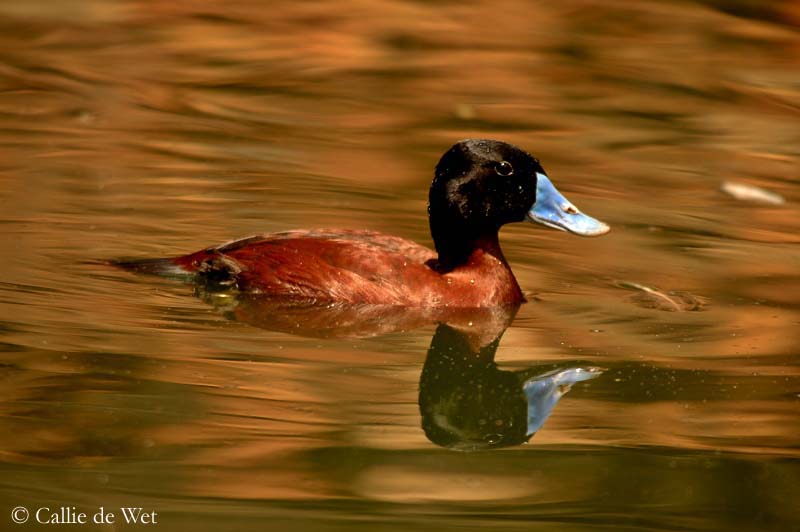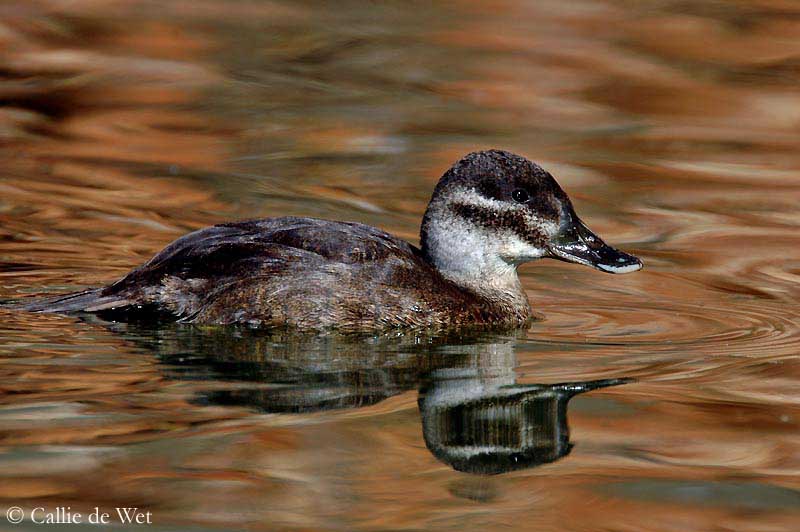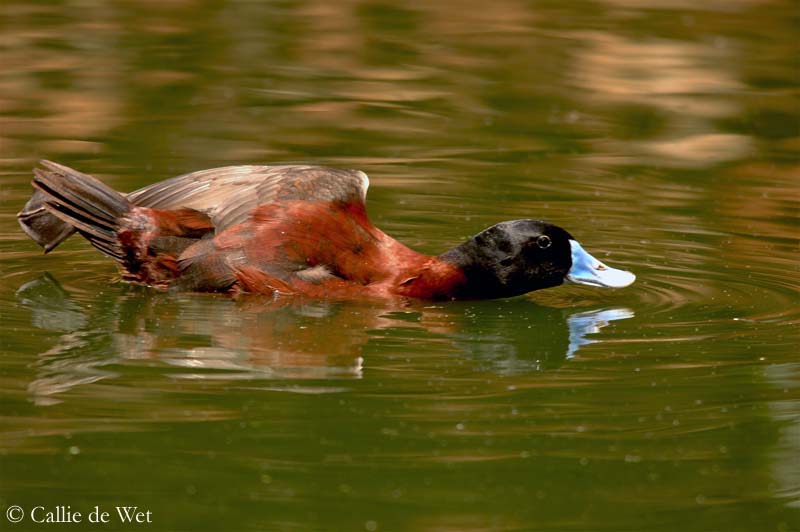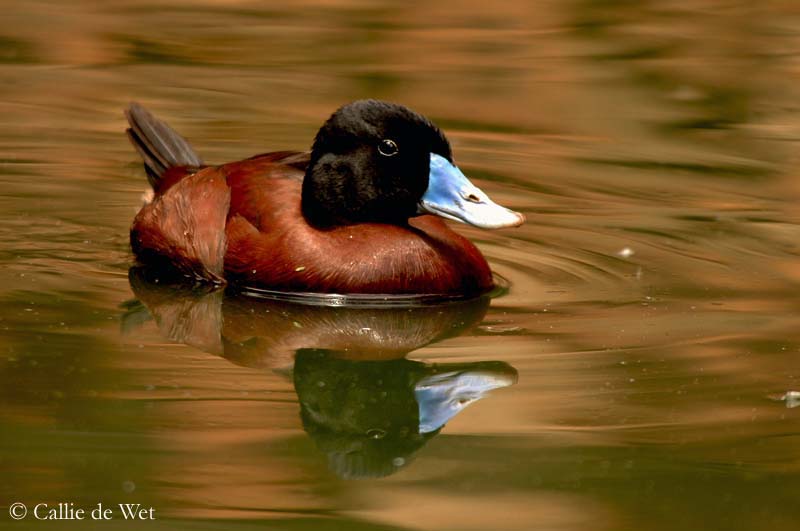
Maccoa Duck
Oxyura maccoa
Anseriforme Order – Anatidae Family
BIOMETRICS:
Length: 48-51 cm ; Weight: 450-820 g
DESCRIPTION:
Maccoa Duck is part of stiff-tailed Ducks. It has long stiff tail feathers erected at 45° when the bird is at rest. It also has a large swollen blue bill.
Maccoa Duck male in breeding plumage has chestnut body. Stiff tail is blackish. Seen in flight, upper wings are dark brown and under wings greyish white. Belly and undertail feathers are whitish. Back and rump are spotted with grey.
Head and neck are black. Large swollen bill is bright blue with large whitish nail. Eyes are dark brown. Legs and webbed feet are grey.


Female and eclipse male have dark brown body. Crown is blackish but throat and cheeks are paler. We can see a whitish stripe under the eye. Bill is grey and less swollen in female than in male.
Juvenile resembles female with duller plumage and pointed tail feathers. It needs at least one year to reach its adult plumage.
VOICE:SOUNDS BY XENO-CANTO
Maccoa Duck is relatively silent, but during courtship displays, male gives croaking, gurgling, growls, and a dry, vibrating “prrr”. Female utters brief growls.
HABITAT:
Maccoa Duck breeds in shallow fresh waters, but it may be found in brackish and saline lakes in winter. It needs dense riparian and emergent vegetation. We can find it from sea level to 3000 metres of elevation.
It rarely frequents coastal areas and prefers quiet waters. Non breeding birds may use habitat without any emergent vegetation.
RANGE:
Maccoa Duck is resident in Africa where there are two populations, one in eastern Africa and the other in South Africa. Movements take place over distances of less than 500 km.
BEHAVIOUR:
Maccoa Duck feeds by diving into shallow water, and it is a bottom feeder, searching for small invertebrates, plants and seeds. It may dive for 15 to 20 seconds. It is a diurnal species.
This duck is shy, less gregarious than other “oxyura”. It can be often found in pair or in family groups, and non–breeding birds gather in small flocks. It rests close to emergent cover vegetation.
When alarmed, Maccoa Duck tends to submerge because it is reluctant to take flight.
Male is very territorial during breeding season. If an intruder or a rival enters its group, it chases it away from the territory.

Courtship displays show the male displaying over water, and it may copulate with several females during the season. Reproduction depends of water level, but it may last from September to December. Males are polygamous. They don’t take part in nesting works, but they defend the territory.
Male is strongly territorial, defending these areas with fixed boundaries, including open waters and emergent vegetation. An individual territory can extend 80 metres along a stand of emergent cover. Male is highly intolerant of other males, and performs aggressive displays to rivals. A successful territorial male may have several females nesting within its territory. Displays include vibrating trumpet calls, one in advertising status, and the other in courting female. Actions and vocalizations are slowly executed. In advertising, male faces and presents its beak full on to the rival. In courting female, male’s body is beside female and beak pointed downwards into the water, displaying the blue swollen part of its bill.
FLIGHT:
Maccoa Duck has to run over the water in order to take off with difficulty. It flies relatively low on short distances.
REPRODUCTION:
Maccoa Duck nests close to the water, at about one metre from water. Nest is built among rushes, and it is made with reeds and leaves. It may also build it on floating vegetation. Nest is a deep round bowl with plant stems pulled down and woven into a bulky bowl-shaped nest, with a deep open cup at 10 to 23 cm above the water. We can see sometimes a ramp from water to cup. Nest may be conspicuous, not especially hidden among vegetation. An old coot’s nest may be used. The nest is anchored to vegetation, and may be prone to flooding if water level is higher.
Female lays about 5 to 6 eggs, sometimes 12, probably laid by two females. Incubation lasts 25 days, by female alone. She may chase the male away from the nest if it approaches too close. Young are fed and cared only by female. At this time, female has a good camouflage with its spotted plumage.
Breeding appears to be related to rainfall.

DIET:
Maccoa Duck feeds on small invertebrates (larvae and gastropods) and plant materials (seeds and roots).
PROTECTION / THREATS / STATUS:
Eastern populations of Maccoa Ducks appear to be in rapid decline. Southern populations seem to be now stabilised after a period of increase. But both populations may be now in decline, due to pollution, increasing of agriculture and industry, and increasing of human urbanisation and leisure’s activities.
Maccoa Duck may be caught and killed in nets used for fishing. It is the major threat for East African populations.
The draining of wet areas and conversion to farmlands is also an important threat.
Pollution in bottom sediments from which Maccoa Duck gets the most part of its food, invading vegetation in South Africa in water bodies and variable water levels, play important roles in breeding and feeding behaviours.
Disturbances and sports hunting are also other threats for this species which numbers are starting to decline again.
Fr: Erismature maccoa
All : Afrikaruderente
Esp : Malvasía Maccoa
Ital : Gobbo maccoa
Nd : Afrikaanse Stekelstaart
Russe : Африканская Савка
Photographs by Callie de Wet
GALLERY
Text by Nicole Bouglouan
Sources :
HANDBOOK OF THE BIRDS OF THE WORLD vol 1 by Josep del Hoyo-Andrew Elliot-Jordi Sargatal - Lynx Edicions - ISBN: 8487334105
BIRDS OF AFRICA SOUTH OF THE SAHARA by Ian Sinclair and Peter Ryan - Princeton University Press Princeton and Oxford - ISBN: 0691118159
BirdLife International (BirdLife International)
SORA Searchable Ornithological Research Archive (Blair O. Wolf)
Wikipedia (Wikipedia, The Free Encyclopedia)